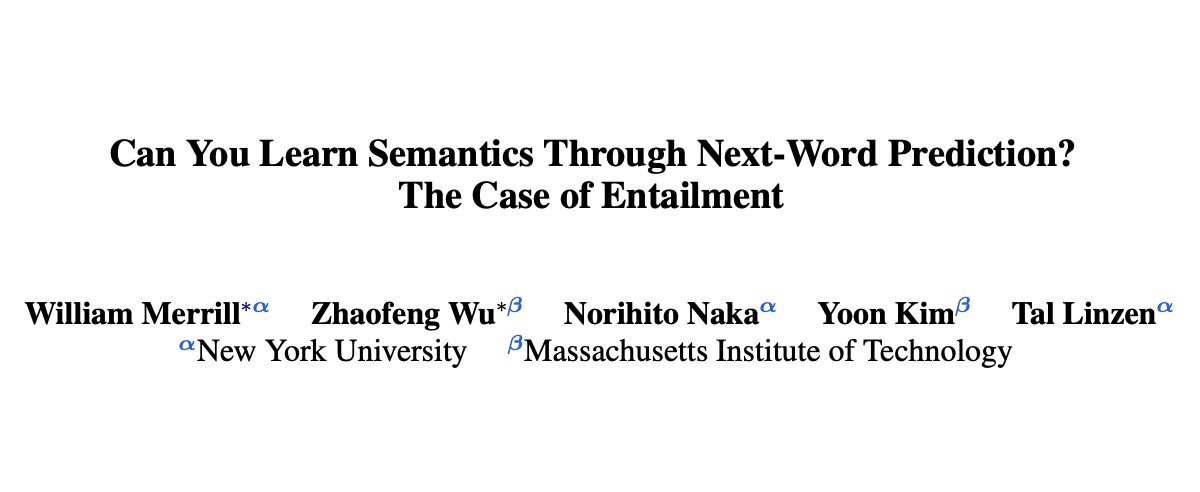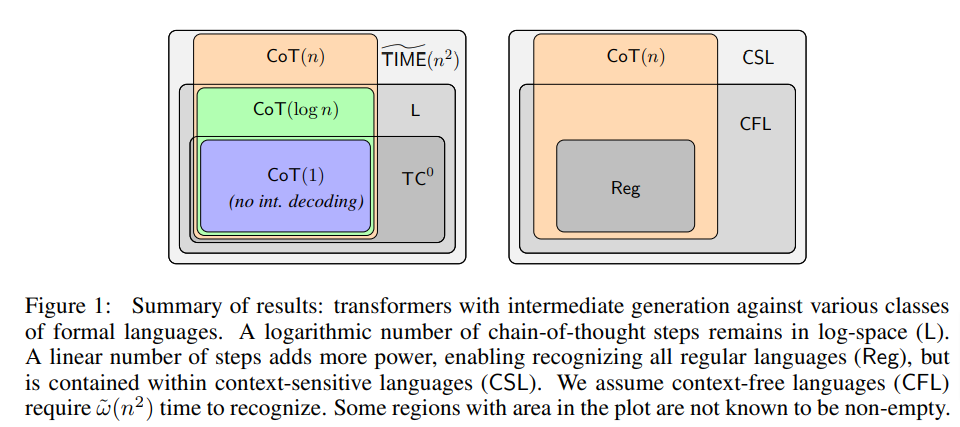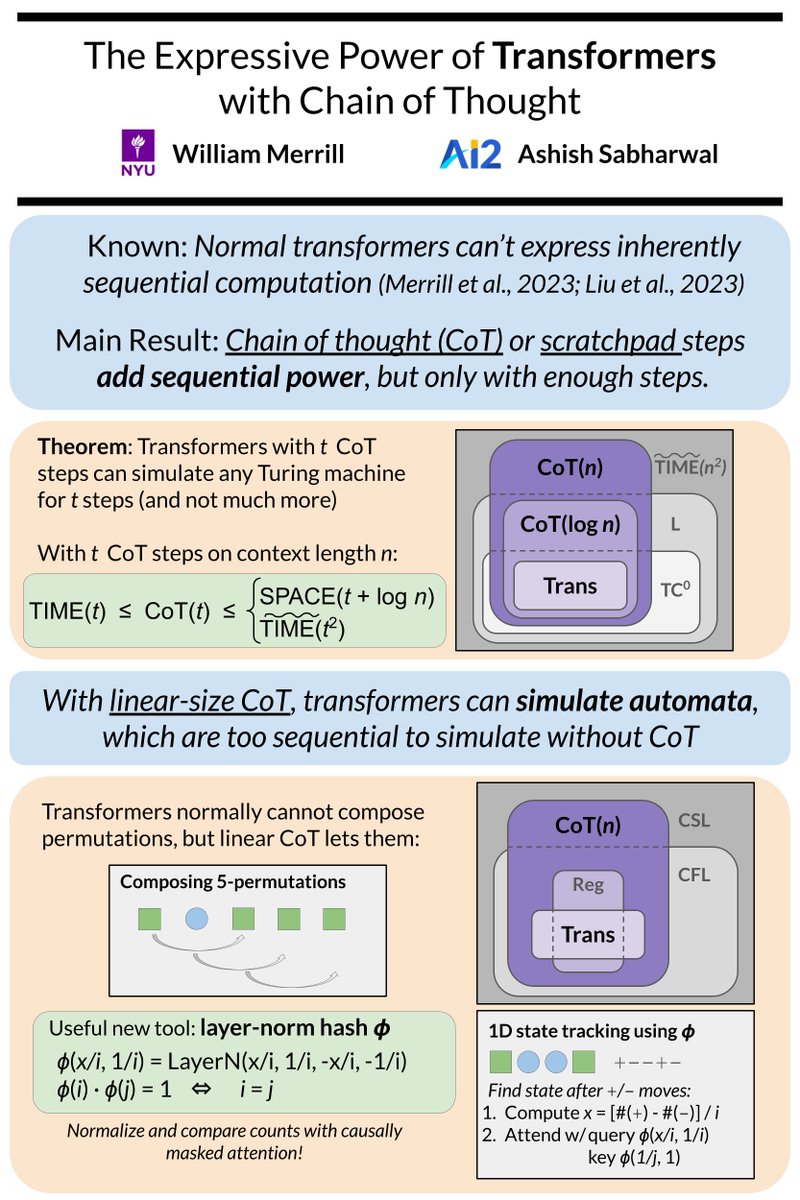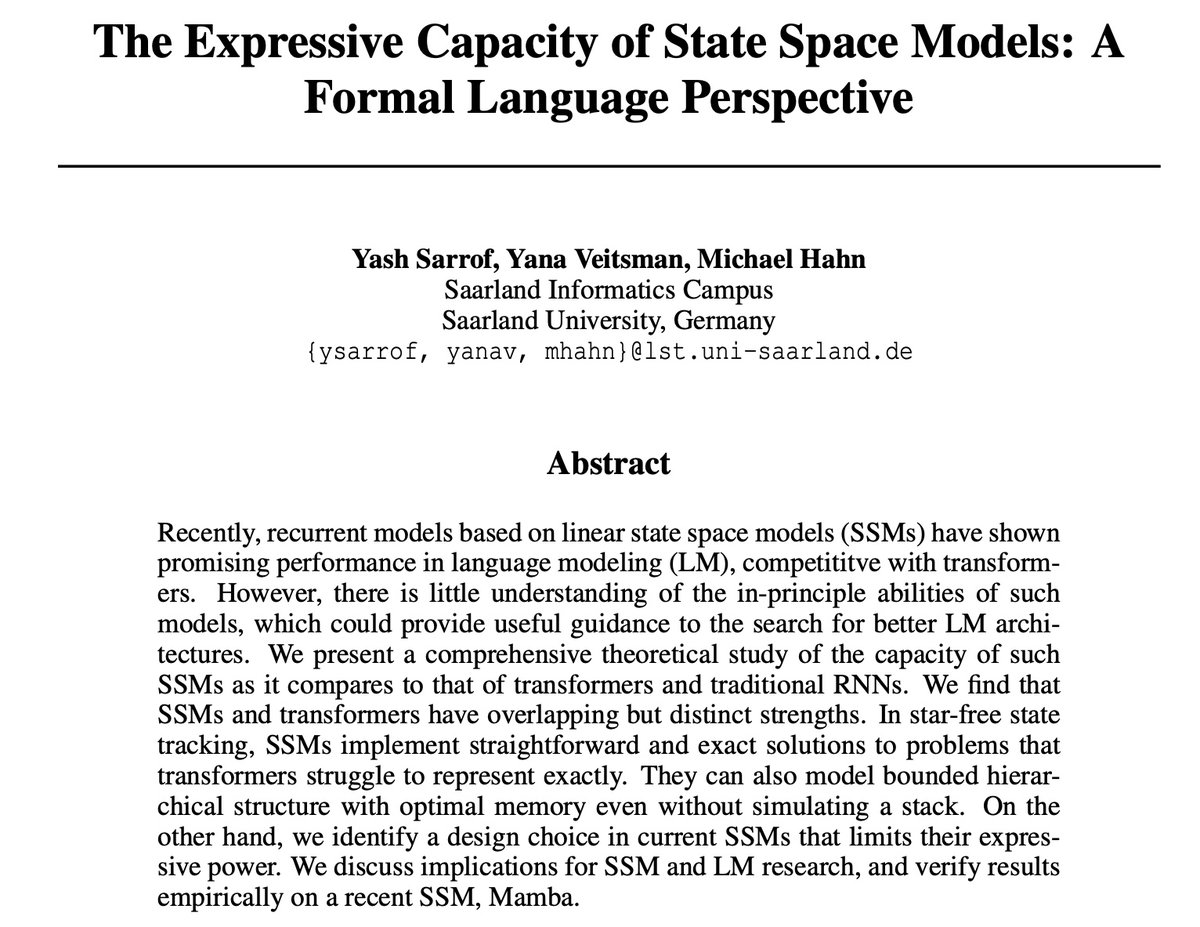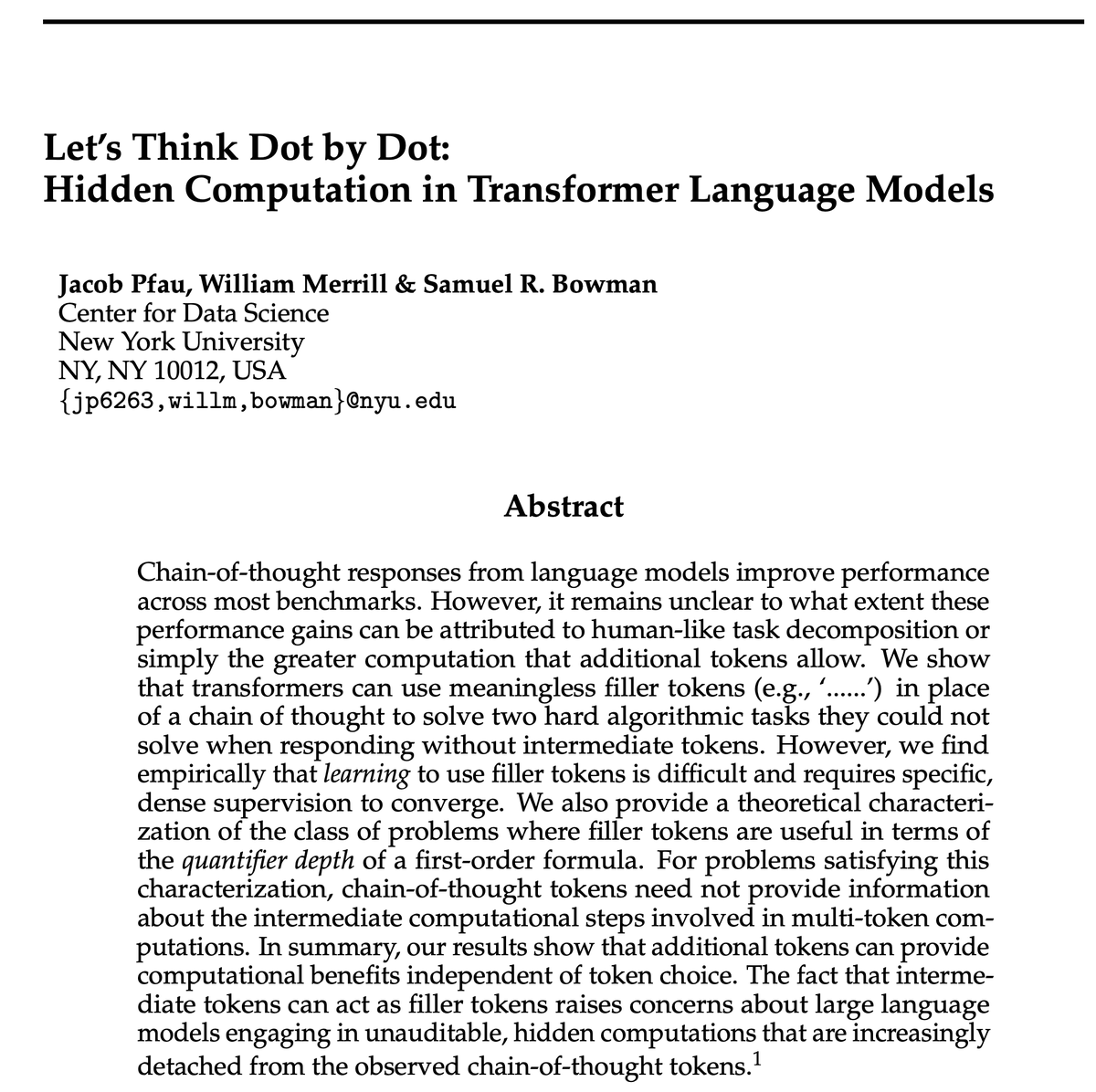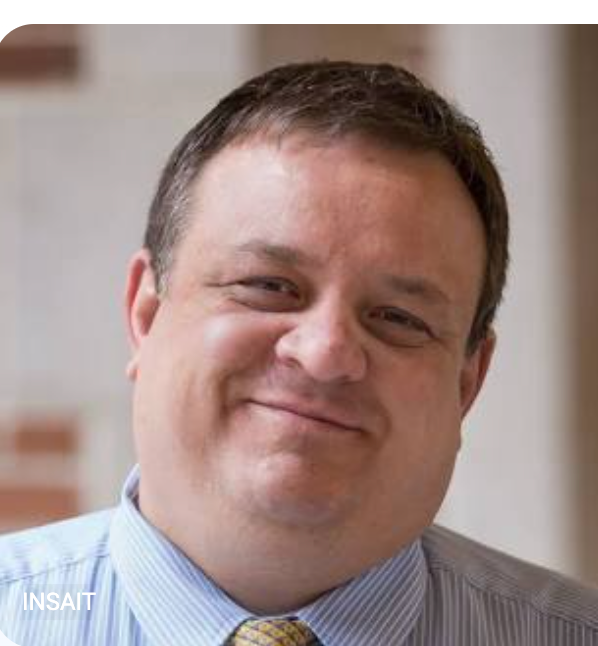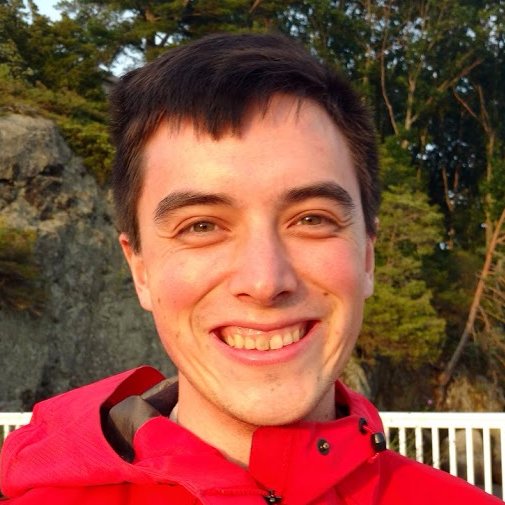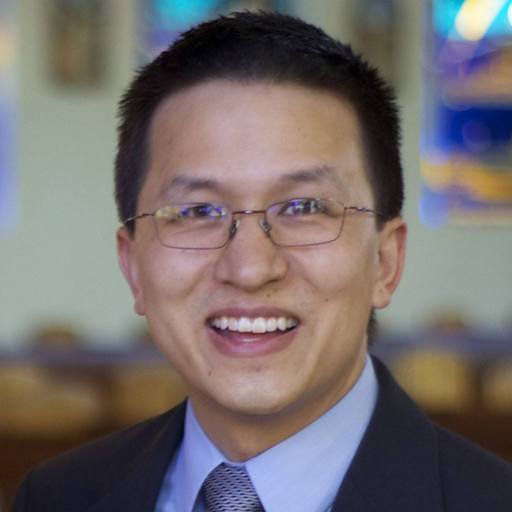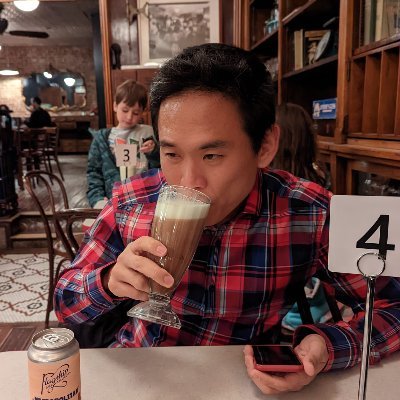
William Merrill
@lambdaviking
Followers
2K
Following
5K
Media
688
Statuses
1K
Will irl - Ph.D. student @NYUDataScience on the academic job market! https://t.co/Tzmx5uMXEv
New York, NY
Joined October 2011
Today in Quanta Magazine, @benbenbrubaker gives a new overview of our work (w/ @Ashish_S_AI) on the expressive power of transformers with/without CoT.
1
11
54
✨Excited to finally drop our new paper: SSMs “look like” RNNs, but we show their statefulness is an illusion🪄🐇. Current SSMs cannot express basic state tracking, but a minimal change fixes this! 👀. w/ @jowenpetty, @Ashish_S_AI.
24
202
1K
📣 @Ashish_S_AI and I prove that transformers can be translated to sentences in first-order logic with majority-vote quantifiers (FOM). FOM is a symbolic language that can capture computation inside transformers!.
12
97
491
[1/6] Excited to share a year-long project re: theory of language understanding in LMs w/ .@a_stadt, @tallinzen. TLDR:.Judging entailments (NLI) can be reduced to LMing over "Gricean data"*.∴ Learning distribution (perfectly) => learning semantics .
2
36
258
A Formal Hierarchy of RNN Architectures -- in which we address questions like "what can an LSTM do that a QRNN can't?". Joint work with @gail_w, @yoavgo, @royschwartz02, @nlpnoah, and @yahave #acl2020nlp . Blog: Paper:
2
60
235
What inductive biases does training impose on transformers?. We find that T5, RoBERTa, etc. are well-approximated by saturated transformers (simplified attention patterns), and explain how this arises during training. w/ @RamanujanVivek @yoavgo @royschwartzNLP @nlpnoah
1
32
163
[1/n] How does a chain of thought change the expressive power of transformers?. New work w/ @Ashish_S_AI studies how adding CoT/decoding steps extends the problems solvable by transformers as a fn of the # of steps.
2
27
130
oh btw, I'm excited to be joining @NYUDataScience as a PhD student this fall!.
12
2
121
Curious about the circuits inside transformers? 🧐. 📢 Our new work shows how (saturated) transformers can be simulated by *threshold circuits*. Equivalently, this bounds the problems saturated transformers can solve in the class TC0. w/ Ashish Sabharwal, @nlpnoah
1
19
120
❗Just updated for ICML:.- General theorem statements (beyond S4 / Mamba).- Experiments showing SSM extensions *can* solve state tracking.- ♟️♟️Fun analysis of chess state tracking complexity (@ chess heads). Paper: w/ @jowenpetty @Ashish_S_AI.
✨Excited to finally drop our new paper: SSMs “look like” RNNs, but we show their statefulness is an illusion🪄🐇. Current SSMs cannot express basic state tracking, but a minimal change fixes this! 👀. w/ @jowenpetty, @Ashish_S_AI.
3
14
115
“The Expressive Power of Transformers with Chain of Thought” w/ @Ashish_S_AI will appear at ICLR 🇦🇹.
Props to Will Merill @lambdaviking for having already fully formalized my nonsense thoughts. (also for generally writing extremely interesting papers)
6
14
97
Stop by "The Expressive Power of Chain of Thought" poster tomorrow!. Wednesday 10:45am #294.
1
15
76
Our NeurIPS paper shows transformers can be expressed in first-order logic with majority quantifiers.=> Extends the theory of the expressiveness and limitations of transformers.=> Provides a "programming language" capturing transformers' computation.
📣 @Ashish_S_AI and I prove that transformers can be translated to sentences in first-order logic with majority-vote quantifiers (FOM). FOM is a symbolic language that can capture computation inside transformers!.
0
16
65
🐊📣 Stop by tomorrow to hear from @Ashish_S_AI and me about:.1) how transformers can be expressed in logic.2) what this means about what transformers *can't* do. Thursday @ 5pm, #1008.
0
10
64
Eagerly anticipating Humanity’s Last Last Exam, Humanity’s Last Last Exam_FINAL, Humanity’s Last Last Exam_FINAL_FINAL, ….
Have a question that is challenging for humans and AI?. We (@ai_risks + @scale_AI) are launching Humanity's Last Exam, a massive collaboration to create the world's toughest AI benchmark. Submit a hard question and become a co-author. Best questions get part of $500,000 in
2
1
67
At ICML? Come check out the Illusion of State poster🪄♟️. Wednesday 11:30 Hall C 4-9 #1013.
✨Excited to finally drop our new paper: SSMs “look like” RNNs, but we show their statefulness is an illusion🪄🐇. Current SSMs cannot express basic state tracking, but a minimal change fixes this! 👀. w/ @jowenpetty, @Ashish_S_AI.
6
9
62
Love to see more theoretical work comparing the formal capabilities of SSMs and transformers (within TC0)!.
We are excited to share our work on characterizing the expressivity of State Space Models (SSMs) with a theoretical lens, using a formal language.framework, backed up by empirical findings. w/ Yana Veitsman, Dr. Michael Hahn.Paper link :
3
7
52
This is a good intuition to impart! There is no true “state” in a transformer (unlike DFA/RNN) and the # of state updates is bounded by the depth. We discuss this more formally here (+implications for what sequential stuff transformers can’t do):
One intuition for why Transformers have difficulty learning sequential tasks (eg parity), w/o scratchpad, is that they can only update their “internal state” in very restricted ways (as defined by Attention). In contrast to e.g RNNs, which can do essentially arbitrary updates.
0
7
43
Was fun working on this!. The cool takeaway imo is that we can characterize the type of reasoning that blank tokens can help with… it’s reduced compared to CoT but experiments show it’s likely more than with no extra tokens.
Do models need to reason in words to benefit from chain-of-thought tokens?. In our experiments, the answer is no! Models can perform on par with CoT using repeated '. ' filler tokens. This raises alignment concerns: Using filler, LMs can do hidden reasoning not visible in CoT🧵
2
4
39
New preprint analyzing the power of uniform attention patterns in transformers in terms of circuit complexity classes. w/ @yoavgo @royschwartzNLP @nlpnoah . Very curious for feedback/suggestions!.
2
10
29
Bibliographic notes:.This paper is a substantially revised version of an earlier preprint. The revisions were inspired by @davidweichiang et al.'s related paper:.
1
1
27
You should give this paper a read 👀. They had me at transformers x Myhill-Nerode thm x pretty maps of NYC🗽.
New paper: How can you tell if a transformer has the right world model?. We trained a transformer to predict directions for NYC taxi rides. The model was good. It could find shortest paths between new points. But had it built a map of NYC? We reconstructed its map and found this:
0
0
24
RIP Drago. In the classes I took and TA'ed with him, Drago was a passionate, kind, and funny teacher and mentor. Gone too soon indeed.
The #AI community, the #computerscience community, the @YaleSEAS community, and humanity have suddenly lost a remarkable person, @dragomir_radev - kind and brilliant, devoted to his family and friends. gone too soon. A sad day @Yale @YINSedge @YaleCompsci #NLP2023
0
3
23
@_jasonwei @OpenAI I'm not sure what you mean by compositionality, but this example is a clear failure on the level of basic Shakespearean grammar. The subject/verb agreement is realllllly off (Should be: thou seekest, I know, shall guide).
0
0
23
#nlphighlights Podcast Ep. 129:. @nlpmattg and I talk with guest @ShunyuYao12 about transformers' ability to process hierarchical structure in language. Thanks to Shunyu for joining us for this fun and informative discussion!.
2
8
22
@_jasonwei So emergent phenomena are an empirical fact (and an interesting one, I agree). But it's a big jump to assume arbitrarily complex (~human-level) reasoning can emerge in transformers. Provably, transformers can only implement express shallow reasoning:
2
0
20
Aug 14 poster: We show sentence co-occurrence prob's from LMs encode information about entailment, illustrating a connection between pragmatics and distributional learning of semantics .w/ @zhaofeng_wu Norihito Naka, Yoon Kim, and @tallinzen .
📢 Preprint: We can predict entailment relations from LM sentence co-occurrence prob. scores. These results suggest predicting sentence co-occurrence may be one way that next-word prediction leads to (partial) semantic representations in LMs🧵
0
4
19
+1, the limitations of LMs workshop was fun and timely. thanks to the organizers and other speakers!. I spoke about complexity-theoretic limitations of transformers (vid will appear eventually). no photo of me in Bielefeld, but did get a pic of another William
I had a great time yesterday speaking about testing the limits of LLMs with Construction Grammar at a workshop on LLM limitations organised by @SAIL_network! .Thanks again to Özge Alacam, @bpaassen1, and @MichielStraat for inviting me, and @lambdaviking for the fun company!
1
0
19
The @SimonsInstitute workshop has been fun so far! Excited for one last day tomorrow.
Will Merrill sharing some updates on his research characterizing the expressivity of transformers at @SimonsInstitute
0
0
18
Next week, I'll be giving a lightning talk at the NYC @GenAICollective about my work using complexity theory to analyze the limitations of transformers!. Tuesday, September 10, 6:30 PM.
0
3
19
Check out this poster if you’re interested in theoretical insights on the reasoning power and limitations of transformers! 👀.
Our poster on "Tighter Bounds on the Expressivity of Transformer Encoders" has been rescheduled to Wednesday at 11am! Exhibit Hall 1 number 228 #ICML2023
0
4
17
Thanks to Meryl for covering our recent work on semantics and language models on the CDS blog!. The paper proves entailment prediction can be reduced to language modeling, and shows how to extract entailment from an “ideal” LM. Check out the blog to learn more!.
Can language models learn meaning just by observing text? CDS PhD student William Merrill (@lambdaviking) and CDS Assistant Professor of Linguistics and Data Science Tal Linzen (@tallinzen) explore the question in a recent study. Read about it on our blog!.
0
2
15
Tomorrow at 12:15!.
Aug 14 poster: We show sentence co-occurrence prob's from LMs encode information about entailment, illustrating a connection between pragmatics and distributional learning of semantics .w/ @zhaofeng_wu Norihito Naka, Yoon Kim, and @tallinzen .
0
0
15
Historical context is hard to get without a lot of experience or clear exposition (this), but it can provide a broader perspective beyond the daily arXiv buzz. glad to see mention of the Stupid Backoff paper about "large language models" c. 2007:
It's not the first time! A dream team of @enfleisig (human eval expert), Adam Lopez (remembers the Stat MT era), @kchonyc (helped end it), and me (pun in title) are here to teach you the history of scale crises and what lessons we can take from them. 🧵
0
2
16
Thanks to Stephen for a great overview of our recent work on the reasoning limitations of transformers!.
In a recent #NeurIPS-accepted paper, CDS PhD student William Merrill (@lambdaviking), with @Ashish_S_AI at AI2, reveal the hidden limitations of transformer LLMs like #ChatGPT and how to detect their "hallucinations.". . #datascience #hallucinations.
0
1
14
Took a look today and this is very interesting stuff! The lower-bound direction is particularly cool: showing how LTL and counter-free automata can be simulated in a transformer through B-RASP.
New preprint! Dana Angluin, I, and Andy Yang @pentagonalize show that masked hard-attention transformers are exactly equivalent to the star-free regular languages.
1
2
13
@egrefen @sleepinyourhat +1 the general sentiment that nothing mystical is happening in our paper: our choice of task is strongly motivated by theory + intuition about what synthetic tasks filler tokens could help on.
1
0
11
@zouharvi (and it may still fail even then; Geiger et al. 2019). Or consider getting rid of the outer parentheses altogether.
1
0
11
Second, formal analysis of transformers, showing limits on the functions they can express (w/ Ashish Sabharwal, @nlpnoah):.
0
3
11
@srush_nlp Agree with the post that there is a distinction (and often implicit conflation) of behavioral and mechanistic induction heads. Having a behavior definition seems more natural to me, followed by specific computational implementations of that def (eg on a transformer) 🧵.
1
2
11
@Ashish_S_AI Also always excited to talk about state-space models and state tracking . (Accepted at ICML 🇦🇹 w/ @jowenpetty @Ashish_S_AI).
1
1
11
@CFGeek @sir_deenicus I’ve worked a lot on analyzing non seq2seq transformers using circuit complexity. with realistic precision they are in tc0 - far from Turing complete!. We’re currently working on extending the analysis to seq2seq transformers, which sounds a bit like what you’re suggesting.
2
0
10



